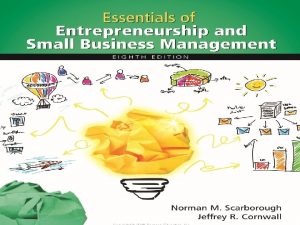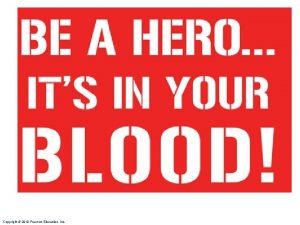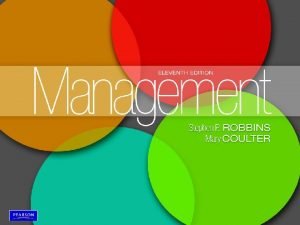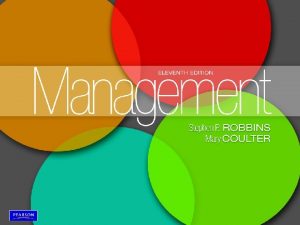Copyright 2016 Pearson Education Inc 1 2 1










































- Slides: 42

Copyright © 2016 Pearson Education, Inc. 1 2 -1

Section 1: The Challenge of Entrepreneurship 2 Ethics and Social Responsibility: Doing the Right Thing Copyright © 2016 Pearson Education, Inc. 2 -2

v. Define business ethics and describe three levels of ethical standards. v. Determine who is responsible for ethical behavior and why ethical lapses occur. v. Explain how to establish and maintain high ethical standards. v. Explain the difference between social entrepreneurs and traditional entrepreneurs. v. Define social responsibility. Copyright © 2016 Pearson Education, Inc. 2 -3

(continued) v. Understand the nature of business’s responsibility to the environment. v. Describe business’s responsibility to employees. v. Discuss business’s responsibility to customers. v. Describe business’s responsibility to investors. v. Describe business’s responsibility to the community. Copyright © 2016 Pearson Education, Inc. 2 -4

v. Ethical behavior: doing what is “right” as opposed to what is “wrong. ” v. Reflects entrepreneur’s personal values and beliefs v. It is important to consider the perspectives of different stakeholders: the various groups and individuals who affect and are affected by a business. Copyright © 2016 Pearson Education, Inc. 2 -5

Copyright © 2016 Pearson Education, Inc. 2 -6

v. Ethics: a branch of philosophy that studies and creates theories about the basic nature of right and wrong, duty, obligation, and virtue. v. Social responsibility: how an organization responds to the needs of the many elements in society. Copyright © 2016 Pearson Education, Inc. 2 -7

v. Business ethics: the fundamental moral values and behavioral standards that form the foundation for the people of an organization as they make decisions and interact with stakeholders. Copyright © 2016 Pearson Education, Inc. 2 -8

Copyright © 2016 Pearson Education, Inc. 2 -9

Copyright © 2016 Pearson Education, Inc. 2 - 10

1. Companies avoid the damaging fallout from unethical behavior on their reputation. 2. Dealing with stakeholders is much easier if a company has a solid ethical foundation on which to build. 3. It is easier to attract and retain quality workers. 4. It has a positive impact on a company’s bottom line. 5. It has an impact on a company’s ability to provide value for its customers. Copyright © 2016 Pearson Education, Inc. 2 - 11

Copyright © 2016 Pearson Education, Inc. 2 - 12

Step 1: Identify the personal moral and ethical principles that shape all business decisions. Step 2: Recognize the ethical dimensions involved in the dilemma or decision. Step 3: Identify the key stakeholders involved and determine how the decision will affect them. v. Triple bottom line (3 BL): measuring business performance using profitability, commitment to ethics and social responsibility, and its impact on the environment (“profit, people, and planet”). Copyright © 2016 Pearson Education, Inc. 2 - 13

(continued) Step 4: Generate alternative choices and distinguish between ethical and unethical responses. Step 5: Choose the “best” ethical response and implement it. Copyright © 2016 Pearson Education, Inc. 2 - 14

Copyright © 2016 Pearson Education, Inc. 2 - 15

v An unethical employee v An unethical organizational culture v Moral blindness v Competitive pressures v Opportunity pressures v Globalization of business Copyright © 2016 Pearson Education, Inc. 2 - 16

Copyright © 2016 Pearson Education, Inc. 2 - 17

v Ethical tests for judging behavior: v The utilitarian principle v Kant’s categorical imperative v The professional ethic v The Golden Rule v The television test v The family test Copyright © 2016 Pearson Education, Inc. 2 - 18

v Honesty v Integrity v Promise-keeping v Fidelity v Fairness v Caring for others v Respect for others v Responsible citizenship v Pursuit of excellence v Accountability Copyright © 2016 Pearson Education, Inc. 2 - 19

v Set the tone. v Create a company credo: v A statement that defines the values underlying the entire company and its ethical responsibilities to its stakeholders. v Establish high standards of behavior. v Involve employees in establishing ethical standards. v Create a culture that emphasizes two-way communication. Copyright © 2016 Pearson Education, Inc. 2 - 20

(continued) v Eliminate “undiscussables. ” v Develop a code of ethics: v A written statement of the standards of behavior and ethical principles a company expects from its employees. v Enforce the code of ethics through policies. v Recruit and promote ethical employees. v Ethical commitment. v Ethical consciousness. v Ethical competency. Copyright © 2016 Pearson Education, Inc. 2 - 21

(continued) v Conduct ethics training. v Reward ethical conduct. v Separate related job duties. v Perform periodic ethical audits. Copyright © 2016 Pearson Education, Inc. 2 - 22

v Social entrepreneurs: v Seek solutions for social problems that are met by neither the market nor the government. v Focus on creating social benefit rather than commercial success. v Tackle social problems by taking full advantage of natural market forces. Copyright © 2016 Pearson Education, Inc. 2 - 23

v Companies must go beyond “doing well” – simply earning a profit – to “doing good” – living up to their social responsibility. v Surveys show: v 55% of small businesses’ mission statements include references to achieving social goals. v 90% of small business owners give to charity and 70% donate both money and time to local causes. Copyright © 2016 Pearson Education, Inc. 2 - 24

v Research shows: v 75% of consumers say social responsibility is important in their purchasing decisions. v There is a positive correlation between ethical, socially responsible behavior and profitability. v But it can be difficult to define just what socially responsible behavior is! Copyright © 2016 Pearson Education, Inc. 2 - 25

v. Encourage recycling. v. Support local fundraisers. v. Join in community service. v. Reduce energy usage. v. Create a grant program. v. Support local causes. v. Partner with local school. Copyright © 2016 Pearson Education, Inc. 2 - 26

v. Socially responsible business owners focus on the three Rs: 1. Reduce the amount of energy and materials used in your company. 2. Reuse whatever you can. 3. Recycle the materials you must dispose of. Copyright © 2016 Pearson Education, Inc. 2 - 27

v. Recognize the value of employees: v. Listen to them and respect their opinions. v. Ask for their input and involve them in the decisionmaking process. v. Provide regular feedback – positive and negative. v. Tell them the truth – always. v. Let them know exactly what’s expected of them. v. Reward them for performing their jobs well. v. Trust them – create an environment of respect and teamwork. Copyright © 2016 Pearson Education, Inc. 2 - 28

Copyright © 2016 Pearson Education, Inc. 2 - 29

Copyright © 2016 Pearson Education, Inc. 2 - 30

v. Use a “SPLENDID” approach: v. Study v. Plan v. Lead v. Encourage v. Notice v. Discussion v. Inclusion v. Dedication Copyright © 2016 Pearson Education, Inc. 2 - 31

v. Business owners need to: v. Assess diversity needs. v. Learn to recognize and correct their own biases and stereotypes. v. Avoid making invalid assumptions. v. Push for diversity in their management teams. v. Concentrate on communication. v. Make diversity a core value in the organization. v. Continue to adjust the company to their workers. Copyright © 2016 Pearson Education, Inc. 2 - 32

v. An effective, proactive drug program should include: v. A written substance abuse policy. v. Training for supervisors to detect substanceabusing workers. v. An employee education program. v. A drug-testing program, when necessary. v. An employee assistance program (EAP): v. A company-provided benefit designed to help reduce workplace problems such as alcoholism, drug addiction, a gambling habit, and other conflicts and to deal with them when they arise. Copyright © 2016 Pearson Education, Inc. 2 - 33

v. Sexual harassment: any unwelcome sexual advance, request for sexual favors, and other verbal or physical sexual conduct made explicitly or implicitly as a condition of employment. v. Small businesses are especially vulnerable because they lack the policies, procedures, and training to prevent it. Copyright © 2016 Pearson Education, Inc. 2 - 34

v. Behaviors that can result in sexual harassment charges: v. Quid pro quo harassment v. Hostile environment v. Harassment by nonemployees Copyright © 2016 Pearson Education, Inc. 2 - 35

v. Education: v Training programs can raise awareness of what constitutes harassment. v. Policy: v Implement a meaningful and enforceable policy against harassment. v. Procedure: v Provide a channel for employees to express their complaints. Copyright © 2016 Pearson Education, Inc. 2 - 36

v. Business owners should: v. Establish a clear policy for monitoring employees’ communications. v. Create guidelines for the proper use of the company’s communication technology and communicate them to everyone. v. Monitor in moderation. Copyright © 2016 Pearson Education, Inc. 2 - 37

v. Businesses should build long-term relationships with their customers. v. Abide by the Consumer Bill of Rights. v. Right to safety. v. Right to know. v. Right to be heard. v. Right to education. v. Right to choice. Copyright © 2016 Pearson Education, Inc. 2 - 38

v. Businesses have a responsibility to: v. Provide investors with an attractive return on their investment. v. Meet ethical and social goals. v. Report their financial performance in an accurate and timely fashion to their investors. Copyright © 2016 Pearson Education, Inc. 2 - 39

v. Businesses have a responsibility to: v. Provide jobs and create wealth. v. Contribute to the community in other ways. v Act as volunteers for community groups. v Participate in projects to help the elderly or poor. v Adopt a highway to promote a clean community. v Volunteer in school programs. Copyright © 2016 Pearson Education, Inc. 2 - 40

v. Businesses must do more than earn profit; they must act ethically and in a socially responsible way. v. But, there is no universal definition of ethical behavior. v. Business owners need to commit to following the highest ethical standards if they expect their employees to do so. Copyright © 2016 Pearson Education, Inc. 2 - 41

Copyright © 2016 Pearson Education, Inc. 2 - 42
 Pearson education inc 4
Pearson education inc 4 2016 pearson education inc
2016 pearson education inc 2016 pearson education inc
2016 pearson education inc 2016 pearson education inc
2016 pearson education inc 2016 pearson education inc
2016 pearson education inc 2016 pearson education inc
2016 pearson education inc 2016 pearson education inc
2016 pearson education inc 2016 pearson education inc
2016 pearson education inc 2016 pearson education inc
2016 pearson education inc 2016 pearson education inc
2016 pearson education inc 2016 pearson education inc
2016 pearson education inc 2016 pearson education inc
2016 pearson education inc Pearson canada inc.
Pearson canada inc. 2016 pearson education inc
2016 pearson education inc Pearson education limited 2017
Pearson education limited 2017 2017 pearson education inc
2017 pearson education inc Copyright 2010 pearson education inc
Copyright 2010 pearson education inc 2009 pearson education inc
2009 pearson education inc 2018 pearson education inc
2018 pearson education inc Copyright 2014 pearson education inc
Copyright 2014 pearson education inc Copyright 2010 pearson education inc
Copyright 2010 pearson education inc Copyright 2010 pearson education inc
Copyright 2010 pearson education inc Copyright by pearson education inc. answers
Copyright by pearson education inc. answers Copyright 2003 pearson education inc
Copyright 2003 pearson education inc Copyright 2009 pearson education inc
Copyright 2009 pearson education inc 2015 pearson education inc
2015 pearson education inc Copyright 2010 pearson education inc
Copyright 2010 pearson education inc Copyright 2010 pearson education inc
Copyright 2010 pearson education inc Copyright 2010 pearson education inc
Copyright 2010 pearson education inc Copyright 2010 pearson education inc
Copyright 2010 pearson education inc Copyright 2010 pearson education inc
Copyright 2010 pearson education inc Copyright 2010 pearson education inc
Copyright 2010 pearson education inc Copyright 2010 pearson education inc
Copyright 2010 pearson education inc Copyright 2009 pearson education inc
Copyright 2009 pearson education inc Copyright 2009 pearson education inc
Copyright 2009 pearson education inc Copyright 2009 pearson education inc
Copyright 2009 pearson education inc 2009 pearson education inc
2009 pearson education inc Copyright pearson education inc
Copyright pearson education inc 2011 pearson education inc
2011 pearson education inc 2011 pearson education inc
2011 pearson education inc Pearson education inc publishing as pearson prentice hall
Pearson education inc publishing as pearson prentice hall Pearson education inc publishing as pearson prentice hall
Pearson education inc publishing as pearson prentice hall Copyright 2008
Copyright 2008

































































